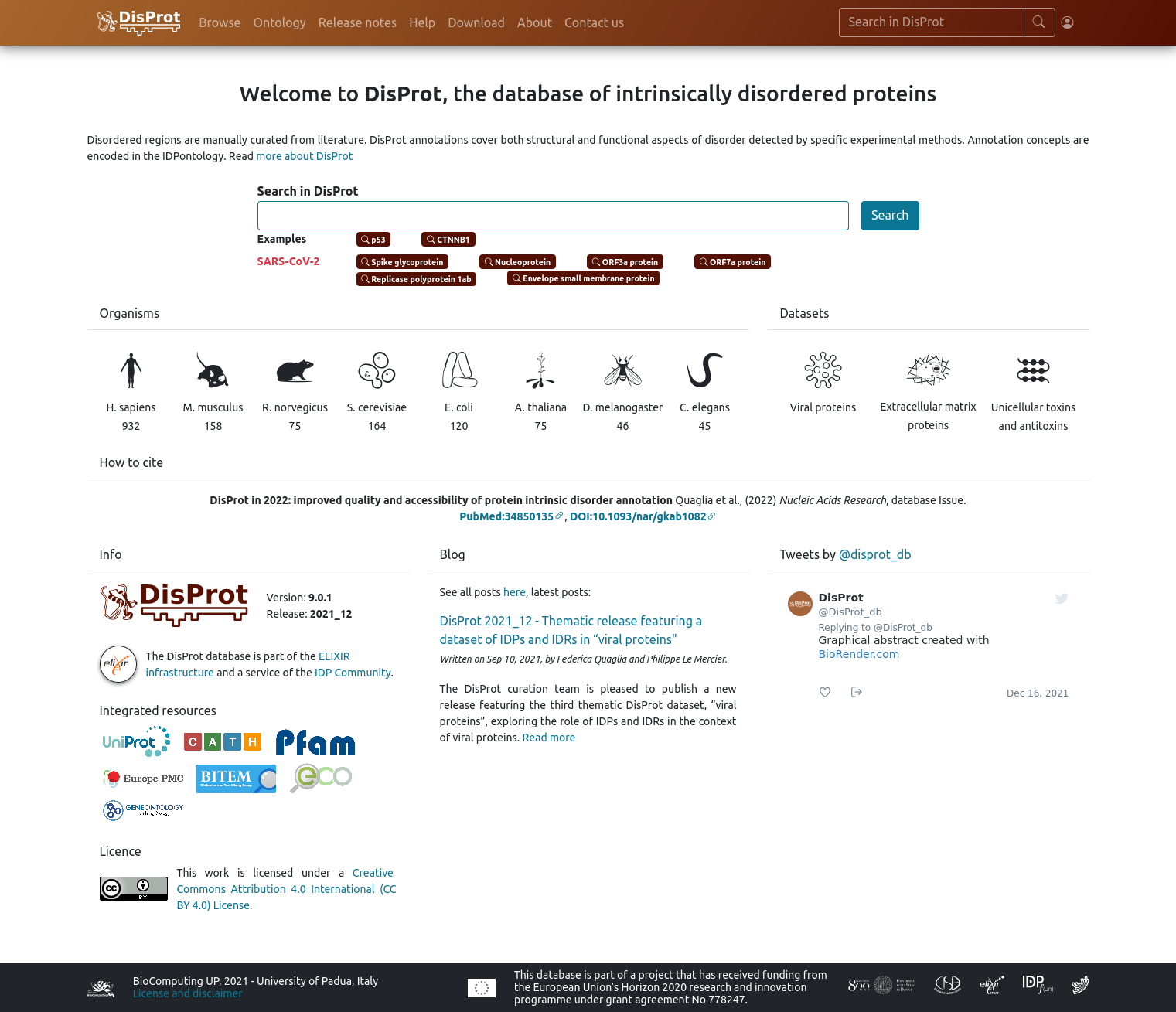Disprot on:
[Wikipedia]
[Google]
[Amazon]
DisProt is a manually curated

DisProt homepageDisProt blog
biological database
Biological databases are libraries of biological sciences, collected from scientific experiments, published literature, high-throughput experiment technology, and computational analysis. They contain information from research areas including genom ...
of intrinsically disordered proteins
In molecular biology, an intrinsically disordered protein (IDP) is a protein that lacks a fixed or ordered three-dimensional structure, typically in the absence of its macromolecular interaction partners, such as other proteins or RNA. IDPs rang ...
(IDPs) and regions (IDRs). DisProt annotations cover state information on the protein but also, when available, its state transitions, interactions and functional aspects of disorder detected by specific experimental methods. DisProt is hosted and maintained in the BioComputing UP laboratory (Dept. of Biomedical Sciences, University of Padua
The University of Padua ( it, Università degli Studi di Padova, UNIPD) is an Italian university located in the city of Padua, region of Veneto, northern Italy. The University of Padua was founded in 1222 by a group of students and teachers from B ...
).
Website
The latest DisProt version, DisProt 9, includes more than 2300 protein entries and more than 4500 pieces of evidence of structural state, state transitions, interactions and functions, along with more than 2500 scientific publications annotated.Biocuration in DisProt
DisProt entries are annotated by professional and community biocurators from experimental data published in scientific literature. The DisProt home page features examples of DisProt entries, i.e. ''p53'' and ''Catenin beta-1'', along with entries of proteins belonging to theSARS-CoV-2
Severe acute respiratory syndrome coronavirus 2 (SARS‑CoV‑2) is a strain of coronavirus that causes COVID-19 (coronavirus disease 2019), the respiratory illness responsible for the ongoing COVID-19 pandemic. The virus previously had a ...
virus, e.g. ''Nucleoprotein''.

Thematic datasets
Starting 2020, DisProt releases ‘''thematic datasets''’ describing biological areas where IDPs are involved in and play a crucial role. All the entries belonging to these datasets are tagged with the name of the ''theme''. * Unicellular toxins and antitoxins (DisProt release 2020_12) * Extracellular matrix proteins (DisProt release 2021_06) * Viral proteins (DisProt release 2021_12)Model organism entries
In the DisProt home page model organisms are represented by an icon, the name of the species and the number of DisProt entries belonging to each specific organism. Entries from the following organisms are accessible from the DisProt home page under the ‘''Organisms''’ section and can be downloaded as single files: ''Homo sapiens, Mus musculus, Rattus norvegicus, Saccharomices cerevisiae, Escherichia coli, Arabidopsis thaliana, Drosophila melanogaster, Caenorhabditis elegans''.DisProt versions and releases
DisProt versions and releases include changes to the website and to the manually curated content of the database. * DisProt 7 (2016): more than 800 protein entries and 1000 publications annotated. Each protein entry in DisProt is characterized by a DisProt identifier which takes the form of the prefix DP followed by a 5 digit protein identifier, e.g. DP00016 corresponds to the ''Cyclin-dependent kinase inhibitor 1 protein''. It featured a new web interface based on Angular.JS. * DisProt 8 (2019): more than 1400 protein entries and over 3000 disordered protein regions. DisProt 8 also introduced the concept of a stable DisProt region identifier. DisProt has been widely used to trainmachine learning
Machine learning (ML) is a field of inquiry devoted to understanding and building methods that 'learn', that is, methods that leverage data to improve performance on some set of tasks. It is seen as a part of artificial intelligence.
Machine ...
(ML) methods to predict disordered regions in proteins. In addition, DisProt has been used to understand the properties of intrinsically unstructured proteins. DisProt 8 featured a new web interface and an extended API and a new annotation interface integrating text mining technologies.
* DisProt 9 (2021): more than 2300 protein entries and more than 4500 pieces of evidence, annotated from over 2500 scientific articles. DisProt 9 features a restyled web interface and a refactored Intrinsically Disordered Proteins Ontology (IDPO). Better interoperability is provided through the adoption of the Gene Ontology
The Gene Ontology (GO) is a major bioinformatics initiative to unify the representation of gene and gene product attributes across all species. More specifically, the project aims to: 1) maintain and develop its controlled vocabulary of gene and g ...
(annotations of interactions and functions of IDPs and IDRs) and the Evidence and Conclusion Ontology (annotations of experimental methods).
DisProt ontologies
DisProt uses three different ontologies to annotate disordered regions, the ''Intrinsically Disordered Proteins Ontology (IDPO),'' the ''Evidence and Conclusion Ontology (ECO)'' and the ''Gene Ontology (GO)''. DisProt has a dedicated page for each IDPO term that include the identifier, name and definition of the term and cross-references to external ontologies, e.g. Gene Ontology. Each IDPO term page list all the DisProt entries annotated with that specific term. * Intrinsically Disordered Proteins Ontology: used to annotate the following types of evidence, 1. structural state (i.e. ''disorder, pre-molten globule, molten globule, order''), 2. structural transition (transitions between structural states), and 3. self-functions (e.g. ''self-inhibition'') and functions associated with the unstructured state of the protein (e.g. ''flexible linker/spacer'') * Evidence and Conclusion Ontology: used to annotate the experimental methods used to assess the presence of intrinsic disorder or one of its aspects, e.g. ''circular dichroism evidence''. * Gene Ontology: used to annotate binding partners, e.g. ''protein binding'', and other functions, e.g. ''RNA folding chaperone''.External links
DisProt homepage
References
{{reflist Biological databases